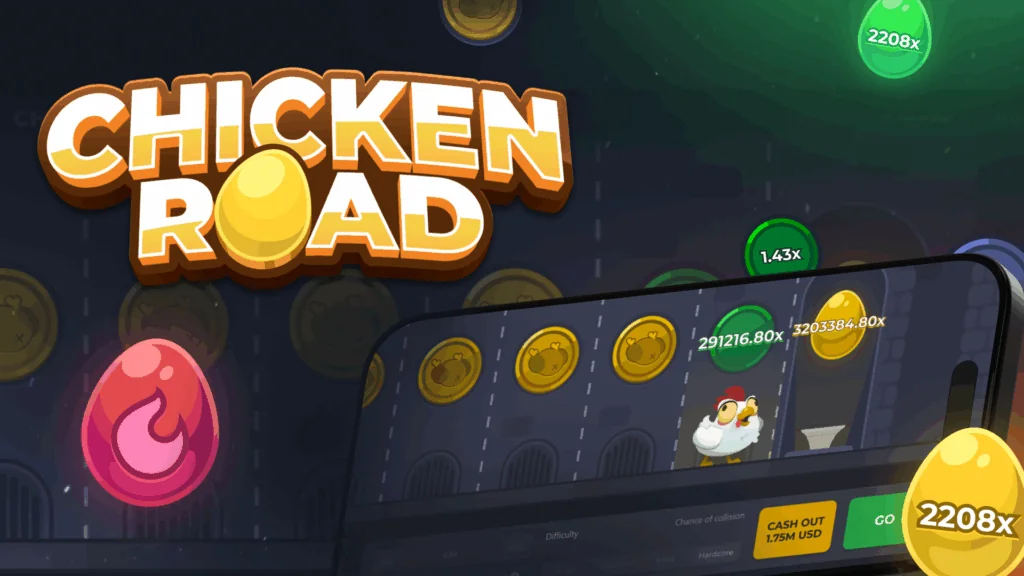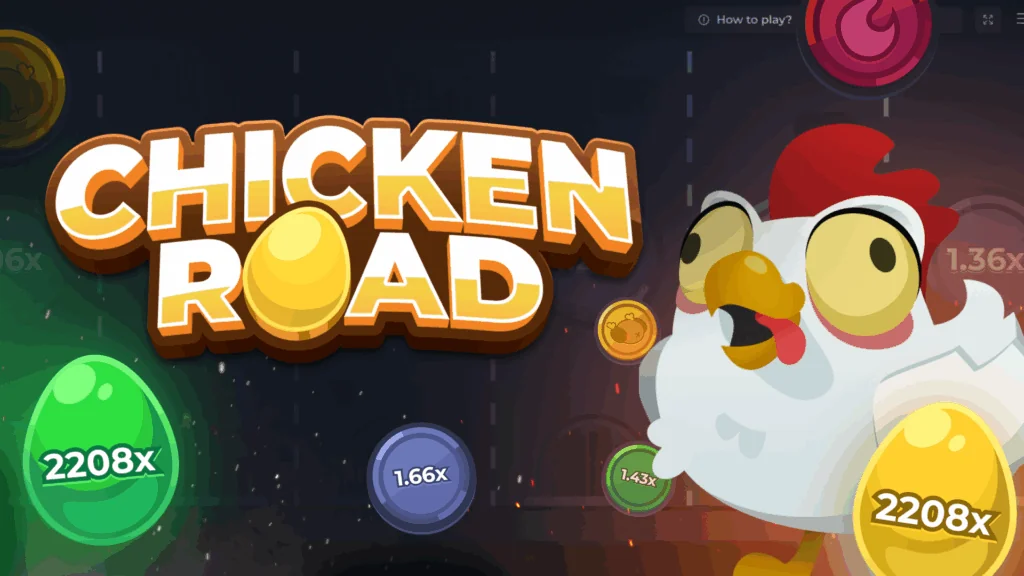Chicken Road — High-Tension Crash Game
Chicken Road takes the classic “cross the road” dare and cranks it into a nerve test where you call the shots: move forward for a bigger payout or cash out before the zap. No reels. No filler. Just timing, judgment, and that split second where your finger hovers over the button and your heart says, “One more step.”
This page is your complete, copy-and-paste guide to Chicken Road: how it plays, what the difficulty modes actually mean, practical strategies, common mistakes to avoid, and a full FAQ. You’ll also find tables, quick-start checklists, and responsible-play guardrails so every session stays sharp and fun.
What Is Chicken Road?
Chicken Road is a crash-style, step-by-step game. A brave cartoon chicken faces a line of covered tiles (think manholes). Some tiles are safe. Some are electrified. Each safe step boosts your multiplier. Each new step raises the risk. You choose when to stop and bank the win — or keep pushing for something bigger.
- Player agency first: You decide every advance. There’s no spinning reel dictating your fate.
- Fast rounds: Sessions play in quick bursts, which makes bankroll pacing crucial.
- Pure visibility: The board, your current payout, and your risk are right in front of you.
If you enjoy games that reward calm nerves and clean timing, Chicken Road is the exact flavor of adrenaline you’re after.
How Chicken Road Works — From First Tap to Cash Out
That’s the entire loop. Simple, readable, and brutally honest about risk and reward.

Difficulty Modes — Risk Curves Explained
Different versions of Chicken Road may label modes slightly differently, but the core idea is consistent: as difficulty rises, safe tiles become rarer and the potential payout climbs faster. Use this table as a mindset map rather than fixed math:
| Mode | Road Length | Safe Tile Density | Multiplier Growth | Best For |
|---|---|---|---|---|
| Easy | Longer | High | Slow-steady | New players, warm-ups, bonus grinding |
| Medium | Moderate | Balanced | Faster | Steady sessions with real tension |
| Hard | Shorter | Low | Rapid | Short, high-impact runs |
| Hardcore/Daredevil | Shortest | Very low | Explosive | Experienced players with strict stop points |
Tip: Pick a mode based on your mood and time. If you want a calmer, extended session, start Easy/Medium. If you want highlight-reel moments in a short burst, go Hard/Hardcore — but pair it with tight limits.
Betting Options & Session Planning
Chicken Road is built for flexible stakes. Exact limits vary by casino/version, but the principle is the same: pick a base bet that lets you make confident, repeatable decisions for the entire session.
| Stake Band | Session Feel | Suggested Approach |
|---|---|---|
| Low (micro to casual) | Longer playtime, low stress | Practice pattern recognition and early cash-outs |
| Mid (standard) | Balanced tension vs. time | Mix modes; lock profits steadily |
| High (short, intense) | High variance, big emotion | Pre-define strict profit/loss exits; keep runs brief |
Rule of thumb: Budget for 20–30 rounds at your default stake. If a single bet size only affords a handful of attempts, drop the stake so you have room to make good decisions under pressure.
Why Chicken Road Hits Different
- Every click matters. You choose the risk, not a spin button.
- Clean feedback. Visual/sound cues build suspense and help you feel the rhythm of play.
- Short learning curve. The rules are easy; mastery is not.
- Portable tension. Works beautifully on mobile for quick, focused sessions.
Practical Strategy — How to Play Smart Without Killing the Fun
There’s no magic pattern that guarantees wins. What you can control is discipline, timing, and the points where you stop. Use these principles:
1) Pre-Plan Your Exits
- Pick a profit lock (e.g., when your current multiplier reaches a number you’re happy with).
- Pick a loss cap (e.g., three full-stake losses or a set % of your session budget).
- Stick to both, even when the board “feels hot.” Emotions lie; math doesn’t care.
2) Calibrate With Easy/Medium
Open sessions on a gentler mode. Cash out earlier than your ego wants. Your brain needs to feel the cadence before you chase bigger spikes.
3) Use Streak Psychology in Your Favor
- After a win: Downshift. Two calm cash-outs beat one greedy misstep.
- After a loss: Pause. Breathe. Consider one low-stake reset round to re-establish rhythm.
4) Keep Steps Intentional
Ask yourself before each move: “If this is my last safe tile, am I okay with it?” If the answer is no, cash out now. Future-you will thank present-you.
5) Demo First, Always
Every version of Chicken Road has a personality. Try the demo to learn animation cues, timing windows, and the feel of each difficulty before real-money runs.
Common Mistakes (and How to Dodge Them)
- Greed locking your finger. If you promised yourself you’d bank two safe steps, bank two safe steps.
- Upsizing after losses. Martingale-style chasing turns a cold stretch into a meltdown.
- Playing tired or tilted. This is a timing game; foggy brains pick bad moments.
- Skipping warm-up. Two minutes in demo saves 20 minutes of frustration.
Audio & Visual Cues — Read the Game Without Overthinking
Chicken Road loves psychological pressure. Expect a soft buzz before a step, a subtle glow on tiles, and a punchy sound on success. Treat these as atmosphere, not prophecy. They’re there to raise your heart rate — not to reveal the next safe spot.
- Use cues to pace. Breathe during the build-up; avoid snap clicks.
- Don’t pattern-hunt. Safe tiles don’t follow your last three guesses.
- Trust your plan. Cues are flavor. Your exits are strategy.
Mobile Play — High Stakes in Your Pocket
Chicken Road is ideal for phones: minimal UI, clear taps, and instant decisions. For the best mobile experience:
- Play in portrait for one-thumb control; switch to landscape if you prefer bigger tiles.
- Enable haptics if your device supports it — the micro-vibrations help with timing focus.
- Keep sessions short and intentional. This is a sprint game, not a marathon.
Bonuses & Promotions — Use Fuel, Don’t Burn It

Some casinos offer free steps, cashback, or limited-time boosts for crash-style games like Chicken Road. These can extend your run if you use them thoughtfully.
- Pair boosts with risk. Use higher-value promos on harder modes where the payout curve is steeper.
- Track contribution. Check whether crash games contribute fully to wagering requirements.
- Respect your envelope. Bonuses are tools — not reasons to ignore stop points.
Session Blueprint — Your First 10 Minutes
- Demo warm-up (2 minutes): Easy mode, two steps then cash out. Repeat until your clicks feel smooth.
- Set real-money boundaries (1 minute): Choose a fixed budget, a profit lock, and a loss cap.
- Live runs (5 minutes): Medium mode, early cash-outs to build confidence.
- Optional spike (2 minutes): One or two Hard/Hardcore attempts within the same limits.
End with a cool-down: one calm run on Easy where you cash out after a single safe step. This closes the session on your terms and helps prevent “one last try” spirals.
Who Will Love Chicken Road (and Who Won’t)
| Chicken Road Clicks For… | Might Not Click For… |
|---|---|
| Players who want control and decision-making each move | Players who prefer passive reels and auto-spins |
| Short, focused bursts of excitement | Very long, low-tension sessions |
| People who enjoy learning timing and rhythm | People who dislike pressure or quick choices |
Responsible Play — Your Guardrails
- Budget like entertainment. Decide what today’s fun costs before you start.
- Use built-in tools. Deposit caps, time reminders, and time-outs exist for a reason.
- Know the signs. If you’re chasing, hiding play, or feeling stressed, stop and take a break.
Winning is great. Sleeping well is better. Keep your sessions intentional, and Chicken Road stays the thrilling mini-game it’s meant to be.
Advanced Tips — Small Edges That Compound
- Two-step baseline: On Easy/Medium, build a habit of banking after two safe steps. It trains discipline and reduces tilt.
- Session triangles: Rotate modes (Easy → Medium → Easy) instead of hammering one difficulty for 20 minutes straight.
- Stake taper: After a highlight win, drop stake size for the next two rounds. Your brain needs recalibration.
- Decision timer: Count a slow “one-two” before each click. Impulsive taps cause most bad beats.
Glossary for New Players
- Crash-style – A game where potential payout grows over time/steps until it ends abruptly.
- Cash out – Bank your current winnings instead of taking another risky step.
- Difficulty mode – Adjusts road length and safe tile density; changes how fast the multiplier climbs.
- Stake – Your bet per round. Set it to support many attempts, not just a few.
Quick Recap — The Chicken Road Mindset
- Simple loop, real decisions.
- Pick a mode that matches your mood and time.
- Plan exits before the first step — and honor them.
- Use demo to sharpen timing and confidence.
- Short, focused sessions beat long, chaotic ones.